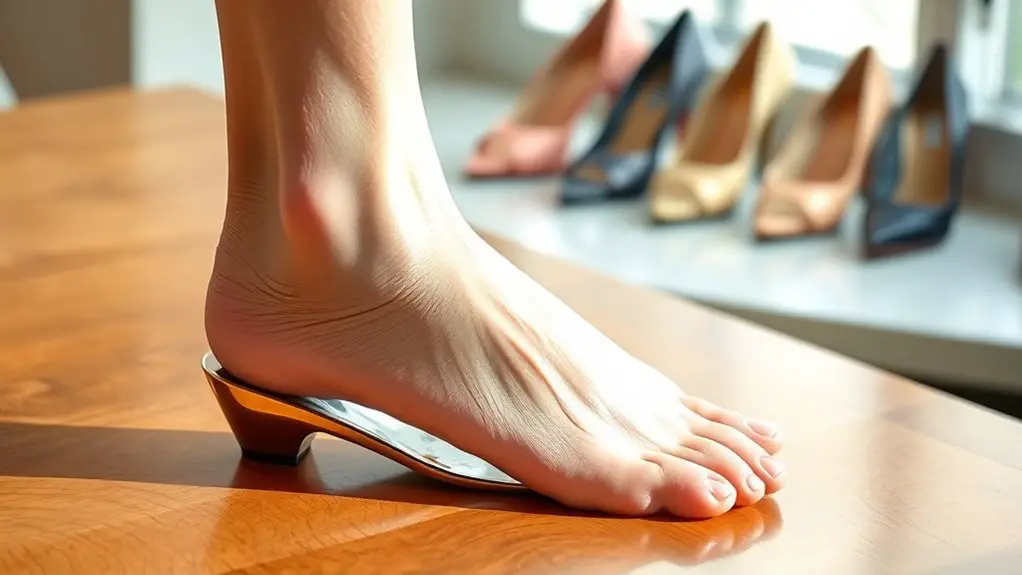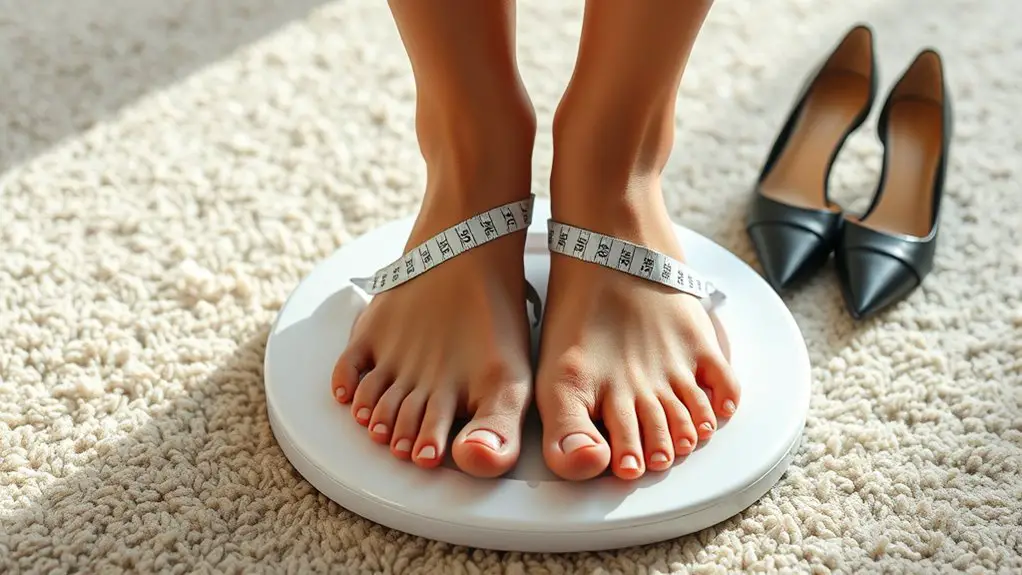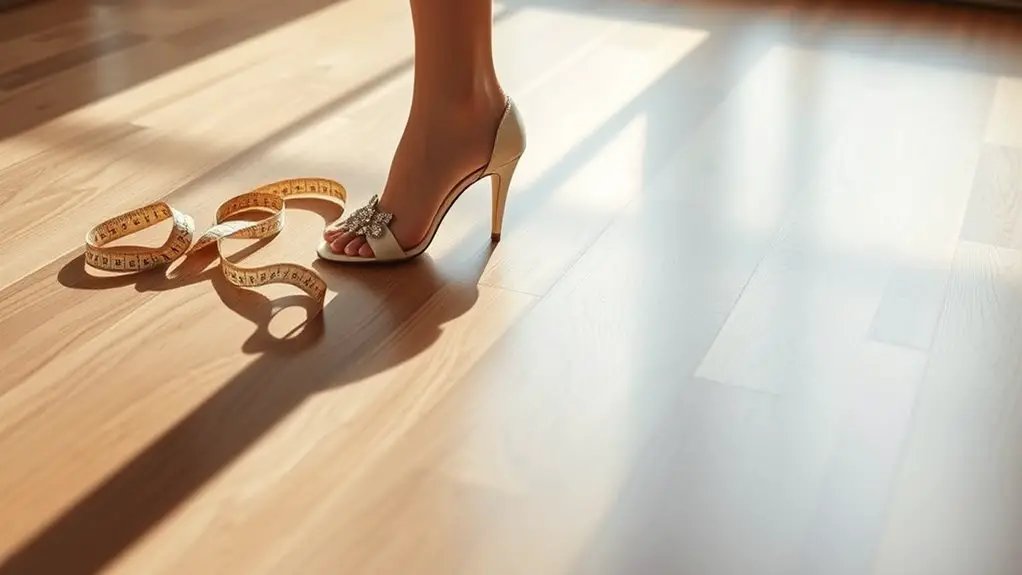To measure your foot properly for heel shopping, start by gathering a flexible tape measure, paper, and a pen. Prepare your feet by washing and relaxing them, then measure length by standing against a wall and marking the longest point. For width, trace your foot and measure at the widest part. Remember to reflect on arch type and shoe styles while trying heels on; comfort and stability are key. Keep going to discover more tips for achieving the perfect fit.
Understanding Foot Anatomy

Understanding the intricate structure of your foot is essential for finding the perfect heel fit. Your foot consists of 26 bones, 33 joints, and numerous muscles and ligaments, all working together to provide support and flexibility. To choose heels that won’t cause discomfort, you need to take into account your foot structure and arch types.
There are three main arch types: neutral, high, and low. A neutral arch distributes weight evenly, while a high arch may lead to excessive pressure on the ball and heel. Conversely, a low arch can result in overpronation, causing instability. Measuring your foot’s length and width, along with identifying your arch type, helps you select heels that accommodate your unique anatomy.
Gather the Necessary Tools
To get accurate measurements of your feet for heel shopping, you’ll need a few essential tools. Proper shoe fitting is vital, and having the right items will guarantee you take precise measurements. Here’s what you’ll need:
Accurate foot measurements are crucial for finding the perfect heels; ensure you have the right tools on hand.
- Measuring Tape: A flexible measuring tape is ideal for wrapping around your foot and getting length and width measurements.
- Paper and Pen: Use these to jot down your measurements and any notes about your foot shape, as this can aid in your shoe selection.
- Ruler: A ruler will help you measure the length of your foot accurately, especially if you’re using a printed shoe measurement chart.
Prepare Your Feet for Measurement

Preparing your feet for measurement is essential to guarantee accurate sizing when shopping for heels. Begin by ensuring proper foot hygiene; wash and dry your feet thoroughly to eliminate any dirt or moisture that could affect the measurement. This step not only promotes cleanliness but also helps you feel more comfortable throughout the process.
Next, consider using relaxation techniques to ease any tension in your feet. Take a few moments to stretch your toes and arches, allowing blood to circulate freely. You might even want to perform gentle foot rolls to alleviate stiffness.
It’s important to measure your feet at the end of the day when they’re slightly swollen, as this will give you a more accurate size for heel shopping. By preparing your feet properly, you’ll set yourself up for success in finding the perfect pair of heels that fit comfortably and stylishly.
Measuring the Length of Your Feet
Measuring the length of your feet accurately is essential for finding the right heel size, and it only takes a few simple steps. Here’s how to guarantee measurement accuracy:
- Gather Your Tools: You’ll need a ruler or measuring tape, and a piece of paper.
- Position Your Foot: Stand on the paper with your heel against the wall. Make sure your weight is evenly distributed.
- Mark and Measure: Mark the longest point of your foot on the paper, then measure from the wall to this mark.
Measuring the Width of Your Feet

To accurately measure the width of your feet, you’ll need a few simple tools, such as a ruler and a piece of paper. Once you have your materials ready, follow a step-by-step process to guarantee precision, and familiarize yourself with width sizing charts to find the perfect fit for your heels. Understanding these elements will help you avoid discomfort and enhance your overall shopping experience.
Tools Needed for Measurement
When it comes to finding the perfect heel, having the right tools for measuring your foot’s width is crucial. Accurate measurements guarantee you choose heels that fit comfortably and look great. Here are three essential measurement tools you’ll need:
- Foot Tape: This flexible measuring tape conforms to your foot’s shape and provides precise width measurements.
- Ruler: If you don’t have foot tape, a standard ruler can also work for measuring the width of your foot.
- Paper and Pen: Use these to jot down your measurements, making it easier to reference when shopping.
With these measurement tools in hand, you’ll be well on your way to finding the perfect heels that fit your unique foot shape, guaranteeing comfort and style.
Step-by-Step Measuring Process
Now that you’ve gathered your measurement tools, it’s time to accurately measure the width of your feet. Start by standing on the paper with your heel against the wall. Trace around your foot, ensuring the pen stays close to the foot’s edge. Measure the widest part of your foot, usually across the ball area. This measurement is essential for finding heels that fit comfortably and support proper foot care.
Here’s a table to help you visualize different foot widths:
| Width Type | Description |
|---|---|
| Narrow | Less than 3 inches |
| Standard | 3 to 4 inches |
| Wide | More than 4 inches |
Understanding your foot width helps in selecting the right shoe materials for comfort and fit.
Understanding Width Sizing Charts
Understanding width sizing charts can greatly enhance your heel shopping experience, as finding the right fit goes beyond just length. To guarantee ideal comfort, familiarize yourself with width terminology and width classifications. Here are three essential points to take into account:
- Width Classifications: Shoes typically come in standard widths: Narrow (N), Medium (M), Wide (W), and Extra Wide (EW).
- Measuring Width: Use a soft measuring tape around the widest part of your foot to determine your width size.
- Try Before You Buy: Always try on heels, as different brands may have variations in width, even within the same classification.
Accounting for Different Shoe Styles
When shopping for heels, it’s essential to understand that different shoe styles come with varying heel heights and widths. A higher heel can shift your weight differently, affecting both comfort and fit, while certain styles may require a wider or narrower fit for ideal support. By considering these factors, you can guarantee that your heel choice not only looks great but also feels comfortable.
Understanding Heel Heights
As you immerse yourself in the world of heels, it’s essential to recognize that heel heights can vary greatly across different shoe styles, impacting both comfort and aesthetics. Understanding these differences can guide your choices for ideal heel comfort while elevating your style.
- Flats: Typically have little to no heel, offering maximum comfort for all-day wear.
- Mid-Heels: Ranging from 2 to 3 inches, they strike a balance between style impact and comfort, perfect for casual or office settings.
- High Heels: Usually over 3 inches, they create dramatic height but may compromise comfort, requiring careful consideration for extended wear.
Choosing the right heel height can greatly enhance your overall look while ensuring you feel comfortable and confident.
Considering Shoe Widths
Choosing the right shoe width is vital for guaranteeing a comfortable fit, especially with heels that can often magnify any discomfort. Width variations play a significant role in shoe comfort, as different styles may require different widths. For instance, a narrow heel might suit a sleek stiletto, while a wider fit may be necessary for a chunky pump. It’s important to measure your foot’s width to determine whether you need a standard, wide, or narrow option. Remember, brands can differ in their sizing, so always try on shoes before purchasing. A proper width guarantees stability and support, allowing you to enjoy your heels without compromising on comfort. Don’t underestimate the impact of width; it’s key to your overall satisfaction.
Trying on Heels: The Final Check
Before you make a purchase, it’s crucial to guarantee your heels fit perfectly, as an ill-fitting shoe can lead to discomfort and even injury. When trying on heels, focus on these three key checks for heel comfort during your final fitting:
- Wiggle Room: Confirm you can comfortably wiggle your toes without feeling cramped. If your toes touch the front, it’s too small.
- Heel Stability: Walk around to check if your heel slips out. A secure fit is essential for stability, especially in higher heels.
- Arch Support: Pay attention to the arch. If you feel pressure or discomfort, it might not be the right heel for you.
Frequently Asked Questions
What if My Feet Are Different Sizes?
Imagine a seesaw; size discrepancies can affect your balance. If your feet differ, focus on the larger size when shopping for heels, ensuring comfort and stability. Custom insoles can also help you find balance more effectively.
How Often Should I Measure My Feet?
You should measure your feet regularly, especially after weight changes or aging. Using proper foot measurement techniques can help avoid common sizing mistakes, ensuring you find the perfect fit for your footwear needs.
Can I Measure My Feet Without Special Tools?
Yes, you can measure your feet without special tools using DIY measuring techniques like a ruler and paper. For foot measurement accuracy, verify you stand upright and trace your foot’s outline carefully for the best results.
Does Foot Size Change With Age?
Yes, your foot size can change with age due to factors like foot growth, weight gain, and hormonal changes. It’s important to measure your feet periodically, especially when buying new shoes, to guarantee proper fit.
Should I Measure My Feet at the End of the Day?
As the sun sets, your feet may swell slightly, making evening measurements more accurate. By measuring then, you’ll account for foot swelling, ensuring your heels fit comfortably, providing the right support for your day ahead.



